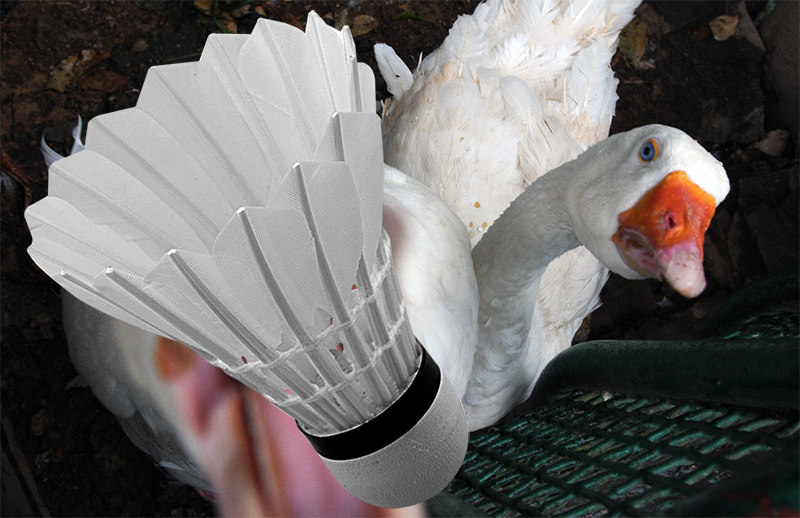Are Birds Suffering for Our Beloved Sport, Badminton?
Have you ever wondered how shuttlecocks are made? I was recently asked this question by a friend during a recent badminton match. He even implied that the feathers used in shuttlecocks might be plucked from live ducks or geese. I was too tired to take such an unfounded claim seriously; hence, I just brushed it aside, but the question has been lingering in my head since then.
Actually, I'm not surprised to hear that claim once more, as it's something I've heard many times before when I was a teenager and started playing badminton. Back then, information wasn't as readily accessible as it is today, and finding answers often required more effort and time. Things are so different now compared to those bygone years. It's incredible how much information is available at our fingertips nowadays.
As I delved into the matter, I decided to conduct a quick online search. I was shocked to find an article that made such a claim! At first, the allegation disturbed me, but it also piqued my curiosity given the gravity of the claim. I couldn't help but wonder how and where the feathers used to make shuttlecocks are sourced, and this has sparked my interest in investigating further.
So far, no videos, no first-hand accounts—nothing to suggest that feathers are plucked from live birds to make feather balls. Also, I believe that the Badminton World Federation (BWF) has a strict code of ethics that includes guidelines on animal welfare. If there were evidence to support the allegation that shuttlecock manufacturers are plucking feathers from live ducks and geese, the BWF would definitely investigate the matter and take appropriate action. However, as I understand it, the BWF doesn't have any control over how manufacturers produce their shuttlecocks.
Having said that, I have looked all over the internet, but despite my best efforts, I have been unable to find detailed information regarding the sourcing of shuttlecock feathers. While there are several videos available on YouTube that showcase the cleaning and screening processes at shuttlecock factories, I was disappointed to find little to no footage that sheds light on the crucial initial stages of feather collection. It would have been helpful to see footage from the farms where the feathers are sourced, providing a clearer picture of the methods used and any potential ethical concerns.
Actually, I am eager to see a response from shuttlecock manufacturers to refute this claim. Nevertheless, I find it quite perplexing that the manufacturers have not felt the need to address the allegation yet. Perhaps they recognized the implausibility of the allegation and saw no need to refute it. As Carl Sagan, the renowned astronomer, famously noted, "Extraordinary claims require extraordinary evidence."
The Controversy of Shuttlecock Feather Sourcing: Separating Fact from Myth
When I first thought about where the feathers came from, I had three scenarios in mind. First, the feathers might have been plucked from live birds. Second, they might have been collected during the molting season, when the feathers naturally fall out. Or, third, the feathers might have been leftovers from the slaughterhouse.
As I mentioned before, the first scenario is pretty unlikely. Plus, since shuttlecock feathers are punched through the middle of the shaft, it doesn't make sense for collectors to pluck the whole feather when they could just snip it instead. Therefore, I think I can confidently dismiss this scenario.

(Image source: https://www.youtube.com/watch?v=9Iz5BKtQcJU&ab_channel=RSLInternational)
You know what's actually kind of reassuring? The fact that shuttlecock feathers mostly come from ducks and geese that are raised for their meat. It's kind of like how leather is a by-product of the beef industry - shuttlecock feathers are a by-product of the poultry industry. So we don't really have to worry about animal cruelty when it comes to making shuttlecocks.
And hey, if you do happen to stumble upon any actual evidence of shuttlecock manufacturers mistreating animals, do let me know. I'd definitely be the first to report it to PETA. It's important to hold companies accountable for any unethical practices, and we need to make sure they're not making a profit at the expense of our love for this wonderful sport. By doing so, we can ensure that the products we use and enjoy are not causing harm to any living beings.
Two Industries, One Connection: The Relationship between Poultry Meat and Shuttlecock Production
Okay, show of hands - who knew that a single shuttlecock had 16 feathers? I bet a lot of you did, but get this - it can take feathers from up to three different birds just to make one of these little guys! I found this out while reading a thesis paper by Terrence Woo called "Understanding the Mechanical Characteristics of Badminton Shuttlecocks," and it totally blew my mind. It just goes to show how much goes into creating these little birdies that we whack back and forth on the badminton court.

(Source: https://dataintelo.com/report/badminton-shuttlecock-market-report/)
I was reading this report by Fact.MR and apparently, the global badminton shuttlecock market was worth a whopping USD 651.60 million in 2022. And get this - if we assume that each shuttlecock costs around USD 2 (which is about the average), that means there were roughly 325 million shuttlecocks sold all over the world in just one year! Just imagine how many little birdies that adds up to!
In fact, almost a billion ducks and geese are needed to meet the demand for shuttlecocks. But don't worry - it's actually pretty fortunate that there are enough feathers to go around, despite the high demand. I know not everyone comes from a place where duck or goose is a popular dish, but in Asia, especially China, these birds are a real delicacy. (Ever heard of Peking Duck? Just thinking about it makes my stomach growl.)
(Image source: https://allasiarecipes.com/recipe/peking-duck-recipe/)
Oh by the way, did you know that a report by indexBox found that in 2018, the global production of duck and goose meat reached a whopping 7.2 million metric tons? That's a lot of birds! Assuming that each goose weighs an average of 4.5 kilograms, that means about 1.6 billion geese were slaughtered to produce that much meat. But the good news is that this also means there are plenty of feathers left over to make shuttlecocks, so we don't need to worry about a shortage.
Well, that’s not entirely true. You know how it is - as badminton continues to capture the hearts of enthusiasts worldwide, more and more people will want to try their hand at it. And with all those new players come more shuttlecocks being used up. So it's only natural that the demand for shuttlecocks will keep going up. The thing is, if duck and goose meat production doesn't keep pace with the increasing demand, there could be a supply shortage one day.
Imagine there’s a bird flu outbreak, like it's happened many times before. Things may get worse; it could be bad news for shuttlecock prices. Last time it happened, the cost of a tube of 12 shuttlecocks skyrocketed by 25% in some countries! While there are synthetic shuttlecocks out there, they just can't quite compare to the real deal.
(MIZUNO Tech Feather 03 is made of synthetic materials with a resin quill and a styrofoam feather finish.)
Honestly, what's really on my mind isn't whether synthetic shuttlecocks can match the performance of natural feathers - although I do think science will eventually catch up with nature. What really concerns me are the environmental issues. The worst thing we could do right now is add more stress to our already fragile ecosystems. We've got enough plastic waste floating around in the ocean, so let's not be careless and exacerbate the problem with plastic shuttlecocks and irresponsible disposal.

